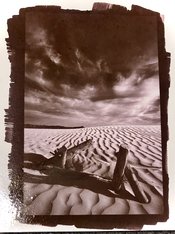I dipped my toes into Kallitypes about a year ago and had some fun. Then put the Kallitype stuff away to focus on silver gelatin printing for a while. Most of the chemicals involved are, I think pretty stable (sodium thiosulfate fixer, clearing bath that's just citric acid and water, etc. etc). But the developer I'm using is 20% sodium citrate in water. Any chance it's still fine or should I plan on tossing what's in the bottle and mixing some up fresh?
Same question for my Ferric Oxalate - I understand that stuff tends to go bad easily which can lead to print fogging? Honestly I can't even remember if I have it in powder form or if I just bought a solution for part B of my sensitizer. It's been stored cool in a glass container out of the light, but for something like 15 months. Heh... now I think about it, do I need to be worried about my silver nitrate?
Same question for my Ferric Oxalate - I understand that stuff tends to go bad easily which can lead to print fogging? Honestly I can't even remember if I have it in powder form or if I just bought a solution for part B of my sensitizer. It's been stored cool in a glass container out of the light, but for something like 15 months. Heh... now I think about it, do I need to be worried about my silver nitrate?




